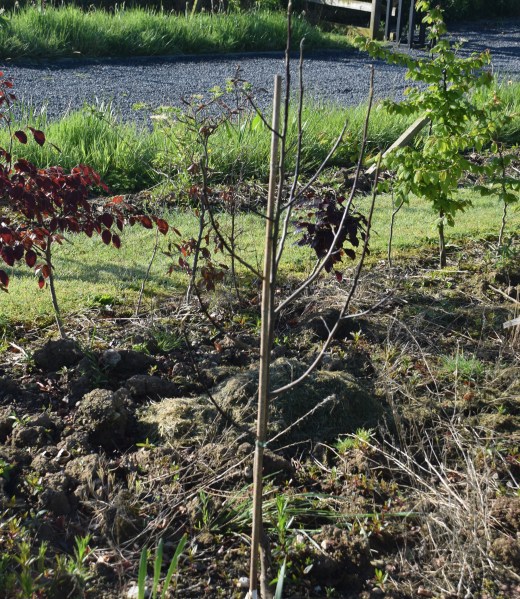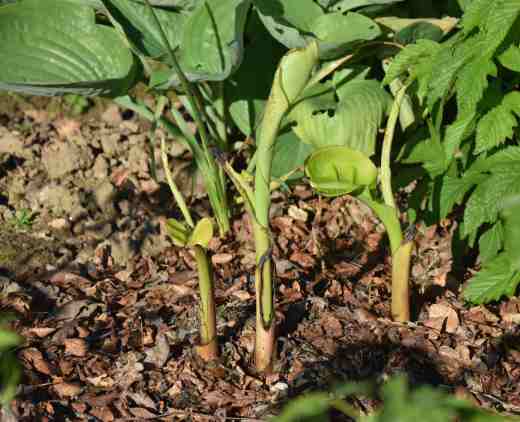‘Hits and Misses’ or ‘you can’t win ’em all’
Making this garden is all about learning. The curve has been steep at times and quite a few plants have surprised me by doing better than expected while others have struggled, or died, unexpectedly. It is too simple to say that a plant is easy to difficult to grow, so much depends on the site, the climate and, to some extent, luck.

I am determined (a stupid thing for a gardener to be and destined for failure) to have magnolias in the garden. I have planted them where I think they will be happy and, in most cases, they have been. But one was planted in the ‘bed of death’. This is a bed, near the bottom of the garden, that has been dug and improved but lays wet in winter. I put in a few things early on and they all died. A philadelphus grew for a year and then died. The same with a bamboo. Typical of plants in poorly drained soil they grew in summer and then started to sprout in spring and then stopped and died. Three birches struggled for three years but, having dug the bed again and made a deep ‘gutter’ round the bed, are now growing strongly. In the best conditions I could provide, a magnolia did well for three years, planted as a 30cm twig. But this spring I knew something was up. It started to swell later than the rest and then stopped. The buds are brown now and it is dead. I will dig the whole area again this winter and add lots of compost to raise the level and start again and I think I will grow squashes there this summer as the area shouldn’t be wet in summer. This winter was very wet and quite mild.

On the other hand, the Musa basjoo is alive! I had this in a pot for a few years, till it got big enough to fend for itself and then it was planted by the front hedge. The site was chosen because it is the most sheltered area in the garden from wind. so the leaves would not get ripped. It is also slightly overhung by the hedge so that should have kept some late frosts off it. But it was dry and rather impoverished soil and the plant grew but didn’t look ‘lush’. I did not protect it this last winter and it was frosted to the ground. I dug it up and moved the rootstock into a newly ‘improved’ bed in March. I covered it with leaves and a cardboard box until a few weeks ago and waited to see what would happen. And three strong shoots give me hope. So much hope in fact that I have planted Dahlia imperialis beside it – talk about setting yourself up for a disaster!

Last year I planted Rhododendron atlanticum ‘Snowbird’. The species is native to the Atlantic Coast states (well I never) from New Jersey to Georgia, and is gorgeous. The white flowers are wonderfully perfumed and my plant has settled well and is covered in bloom.

Once again the two Malus toringo ‘Freja’ are covered in flowers. There are as many flowers and leaves. Later there will be tiny fruits too. Usually these are buzzing with honey bees but they are strangely silent this year. That worries me. Sometimes I plant something that makes me joyous every year and these are among those plants.

The same is true of Viburnum plicatum ‘Shasta’. If left to grow as it likes Viburnum plicatum in all its forms is colourful and of superb shape. I went for a walk the other day and saw one in a garden clipped into a tube. It was still covered in flowers but it looked so wrong. I like topiary and clipped hedges but these viburnums should never be treated in this way. But then I don’t like to see dogs dressed as Darth Vader or cats in bows so…

I have not indulged Viburnum opulus ‘Roseum’ in any of my own gardens before because I have never had the room. But now I have a pair, either side of a path. And, being able to enjoy the transition from lime green to pure white as the globes of delicate flowers mature, I really appreciate the beauty of the thing. Being sterile, there are no berries, but I also have ‘Aureum’ which has fertile flowers and those lovely red, translucent fruit. It seems odd that the plant is called ‘Roseum’ since the flowers are white but it is possibly because the individual sterile florets resemble single roses. It is commonly called Guelder rose because it originated in Gelderland in the the Netherlands but that name is now used for all forms of the species. It was introduced to the UK in the 16th century and was also called Sambucus rosea or Rose elder. It is rather uninteresting the rest of the year, has no scent, and can suffer from blackfly but it is tough and easy and that is welcome.

Canna! They enjoy damp situations. Of course, they are related to the Musa basjoo. If the Musa basjoo corm survives winter there, Canna rhizomes might also. The only problem is that their vigorous and abundant foliage overwhelms more desirable vegetation during the summer.
It has been a funny old winter and I have been surprised at what has died. In one bed I have pittosporum tobira and a bronze corokia with no hint of damage but between them the new Viburnum ‘Coppertop’ looks pretty dead. It is being heavily promoted and I was suckered in! I left some cannas in the ground purely out of laziness and they are all coming up! I think they are able to tolerate the winter wet as long as it is not too cold. I only wish they did have abundant vegetation – I would tolerate them trying to overwhelm anything!
Goodness, although I am unfamiliar with most Viburnum, I would expect any that I am familiar with to tolerate more frost than any of the Pittosporum that I am familiar with.
Are your Canna the tall sort? I do not know of many Canna that do not grow like weeds. The shorter sort are less overwhelming.
As far as I am aware ‘Coppertop’ was selected in Florida so maybe I was hopelessly optimistic to think it would be hardy here – but it is being promoted as hardy. I certainly would not have expected it to drop its foliage, and to die back, at the first hint of frost while bigleaf hydrangeas and Pittosporum tobira were untouched! The cannas are all tall – I can’t stand dwarf cannas – what is the point! They are ‘on the edge’ here because we don’t get the heat and they need lots of water. When it is warm here it is usually dry. They are best in pots really. If I manage to make the awful soil I have full of organic matter then they will do better outside.
The allure of dwarf Canna escapes me also, like dwarf Gladiolus and dwarf bearded Iris, but even more so, since their foliage is more appealing than their bloom. They certainly appreciate warmth. I do not consider that much, since even the cool climates here are warm enough for them.
What a great reminder that gardening is a constant learning process and that success and failure can depend on various factors. It’s inspiring to see your determination to keep trying and experimenting with different plants and techniques.
Thank you